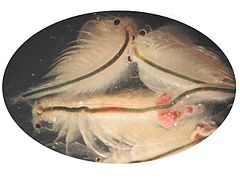Sea-Monkeys
It has been suggested that this article be merged into Brine shrimp and Talk:Brine shrimp#Merge. (Discuss) Proposed since April 2007. |

Sea-Monkey is a brand name of a variant (sometimes known as Artemia nyos) of Artemia salina, a species of brine shrimp, a type of fairy shrimp — not true shrimp, but a branchiopod. The term "Sea-Monkeys" (sometimes unhyphenated) is a trademark used to sell them as a novelty pet, often advertised in comic books. Brine shrimp originate in salt lakes and salt evaporation flats.
Biology
Sea-Monkeys can reproduce both sexually (requiring a male and a female) and asexually. When the eggs are laid, there are fewer males than females per "litter". This is probably because they are not needed for reproduction. Females stop reproducing with the males when the males are too few.
Sea-Monkeys have been cited in studies of DNA and sexual behavior, primarily because they are commonly available specimens.
Sea-Monkeys are a cultivated variety, possibly subspecies, of Artemia salina (brine shrimp), sometimes classified as a new species called Artemia nyos. They were bred for their larger size and longer lifespan, making them more suitable as pets than the original breed of brine shrimp. The U.S. patent 3,673,986 granted in 1972 describes this as "hatching brine shrimp or similar crustaceans in tap water to give the appearance of instantaneous hatching." Advertisements for Sea-Monkeys were widespread in comics in the 1970s, featuring drawings of smiling humanoid creatures that bore little resemblance to brine shrimp.
The key observation that allowed unhatched "Sea-Monkeys" to be cheaply packaged, shipped, and handled is that, in certain easily prepared environments, they enter cryptobiosis, a natural state of suspended animation. When released into their aquarium they leave this state and hatch.
Life cycle
Basically, one adds the 'water purifier' package on day one. The user is typically unaware that this package already contains eggs in addition to the salt. At day two, one adds the 'instant life eggs' package, containing Epsom salts, borax and soda[disambiguation needed], in addition to eggs, yeast, and a blue dye. The blue dye is used to enhance the 'instant life' experience by making the freshly hatched animals more visible. The Sea-Monkeys seen during the second day after adding the 'eggs package' are derived from the eggs added with the 'purifier' package. The food package is a mixture of Spirulina and dried yeast. The 'boost' packages mainly contain salts, which induce sexual activity in artemia.
Sea-Monkeys have a biological life cycle of one year, but thanks to their ability to enter cryptobiosis, the product guarantees that the Sea-Monkeys live for up to 2 years. This should be understood as the colony being able to sustain itself for two years.
History
Sea Monkeys were first marketed in 1957 by Harold von Braunhut as Instant Life, though Braunhut changed the name to "Sea-Monkeys" on May 10, 1962. Many types of Sea-Monkey kits are now available. The company produces the original Ocean View tank as well as a variety of other products. The Sea-Monkeys company is now part of Educational Insights, and as of 2005 it is headed by George C. Atamian and son-in-law David Horvitz.
As of 2005, there are even "Sea-Monkeys" themed slot machines.[1]
Other companies have distributed toys along the "Sea-Monkey" model including Wham-o and Dr. Jordan's Formulas 'THE SWARM' product.
External links
- The Official Sea Monkey Website
- "Not From a Sea. Not Monkeys. Discuss." — The New York Times May 15, 2005.(Registration required)
- U.S. patent 3,673,986
- Captain's Artemia pages
